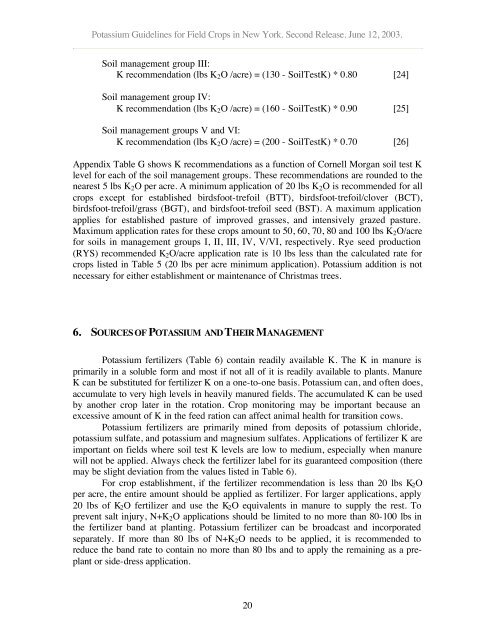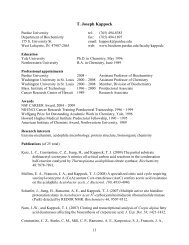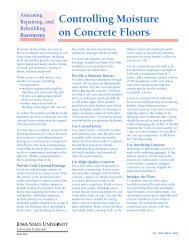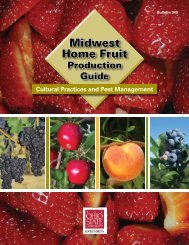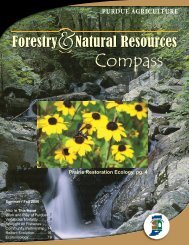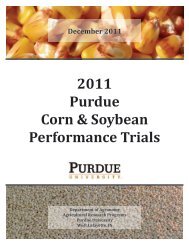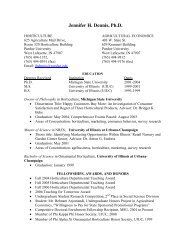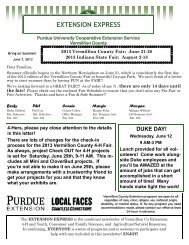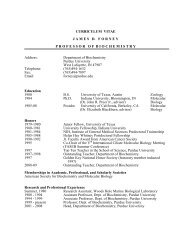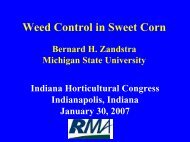potassium guidelines for field crops in new york - Purdue Agriculture
potassium guidelines for field crops in new york - Purdue Agriculture
potassium guidelines for field crops in new york - Purdue Agriculture
Create successful ePaper yourself
Turn your PDF publications into a flip-book with our unique Google optimized e-Paper software.
Potassium Guidel<strong>in</strong>es <strong>for</strong> Field Crops <strong>in</strong> New York. Second Release. June 12, 2003.Soil management group III:K recommendation (lbs K 2 O /acre) = (130 - SoilTestK) * 0.80 [24]Soil management group IV:K recommendation (lbs K 2 O /acre) = (160 - SoilTestK) * 0.90 [25]Soil management groups V and VI:K recommendation (lbs K 2 O /acre) = (200 - SoilTestK) * 0.70 [26]Appendix Table G shows K recommendations as a function of Cornell Morgan soil test Klevel <strong>for</strong> each of the soil management groups. These recommendations are rounded to thenearest 5 lbs K 2 O per acre. A m<strong>in</strong>imum application of 20 lbs K 2 O is recommended <strong>for</strong> all<strong>crops</strong> except <strong>for</strong> established birdsfoot-trefoil (BTT), birdsfoot-trefoil/clover (BCT),birdsfoot-trefoil/grass (BGT), and birdsfoot-trefoil seed (BST). A maximum applicationapplies <strong>for</strong> established pasture of improved grasses, and <strong>in</strong>tensively grazed pasture.Maximum application rates <strong>for</strong> these <strong>crops</strong> amount to 50, 60, 70, 80 and 100 lbs K 2 O/acre<strong>for</strong> soils <strong>in</strong> management groups I, II, III, IV, V/VI, respectively. Rye seed production(RYS) recommended K 2 O/acre application rate is 10 lbs less than the calculated rate <strong>for</strong><strong>crops</strong> listed <strong>in</strong> Table 5 (20 lbs per acre m<strong>in</strong>imum application). Potassium addition is notnecessary <strong>for</strong> either establishment or ma<strong>in</strong>tenance of Christmas trees.6. SOURCES OF POTASSIUM AND THEIR MANAGEMENTPotassium fertilizers (Table 6) conta<strong>in</strong> readily available K. The K <strong>in</strong> manure isprimarily <strong>in</strong> a soluble <strong>for</strong>m and most if not all of it is readily available to plants. ManureK can be substituted <strong>for</strong> fertilizer K on a one-to-one basis. Potassium can, and often does,accumulate to very high levels <strong>in</strong> heavily manured <strong>field</strong>s. The accumulated K can be usedby another crop later <strong>in</strong> the rotation. Crop monitor<strong>in</strong>g may be important because anexcessive amount of K <strong>in</strong> the feed ration can affect animal health <strong>for</strong> transition cows.Potassium fertilizers are primarily m<strong>in</strong>ed from deposits of <strong>potassium</strong> chloride,<strong>potassium</strong> sulfate, and <strong>potassium</strong> and magnesium sulfates. Applications of fertilizer K areimportant on <strong>field</strong>s where soil test K levels are low to medium, especially when manurewill not be applied. Always check the fertilizer label <strong>for</strong> its guaranteed composition (theremay be slight deviation from the values listed <strong>in</strong> Table 6).For crop establishment, if the fertilizer recommendation is less than 20 lbs K 2 Oper acre, the entire amount should be applied as fertilizer. For larger applications, apply20 lbs of K 2 O fertilizer and use the K 2 O equivalents <strong>in</strong> manure to supply the rest. Toprevent salt <strong>in</strong>jury, N+K 2 O applications should be limited to no more than 80-100 lbs <strong>in</strong>the fertilizer band at plant<strong>in</strong>g. Potassium fertilizer can be broadcast and <strong>in</strong>corporatedseparately. If more than 80 lbs of N+K 2 O needs to be applied, it is recommended toreduce the band rate to conta<strong>in</strong> no more than 80 lbs and to apply the rema<strong>in</strong><strong>in</strong>g as a preplantor side-dress application.20


